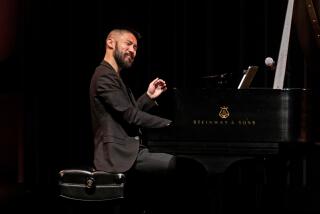What was the peak? Anything he played
- Share via
Already, at 36, a world-class figure among pianists, Piotr Anderszewski returned to Southern California on Wednesday night for his first solo recital in Walt Disney Concert Hall. The occasion was auspicious, the auditorium close to capacity and the piano playing flawless.
In a challenging and provocative program, the high point for some listeners may have been the magisterial drama of the opening, Mozart’s Fantasia and Sonata in C minor, an important pairing establishing immediately the Polish musician’s impeccable musical credentials. For others, no doubt, the climax was Bach’s Sixth English Suite, which closed the evening with heart-racing excitement and seraphic tranquillity.
But for at least one listener, the peak of this ear-opening event came at its center, in three Mazurkas from Chopin’s Opus 59. These were simply laid out but deeply detailed mementos of the composer’s Polish roots and his lifelong homesickness -- emotional souvenirs of home and hearth. The trills in the first, in A minor, could make one weep for their emotional content alone, and what followed was equally touching.
Depth of feeling also pervaded Anderszewski’s virtuosic and liquid playing of Karol Szymanowski’s three “Metopes,” Opus 29, compelling sound pictures of a watery, mythical world in the aristocratic Polish composer’s post-Impressionistic, often whole-tone style.
With fantastical imaginings that sometimes deal in Schumannesque whimsy, Szymanowski creates a world of beguiling colors. The young pianist gave the composer his due in ravishing sound, the entirety drenched in beauty, the kind few others find at the keyboard.
Bach’s D-minor suite capped the event with motivated speed, inexorable continuity and exquisite delineation of soft playing. Anderszewski has all the technical equipment to play as loudly, boldly and aggressively as he wishes. More important, he commands at the quiet end of the spectrum the deepest, most sensuous range of gentle and faceted pianissimos since -- whom? Walter Gieseking? Myra Hess?
His playing of the Double Sarabande was focused and followable, yet he achieved nearly unbelievable levels of quiet and held his listeners rapt for minutes. After this feat, a musical triumph and unique achievement, he played a most appropriate encore: the Sarabande from Bach’s B-flat Partita.
More to Read
The biggest entertainment stories
Get our big stories about Hollywood, film, television, music, arts, culture and more right in your inbox as soon as they publish.
You may occasionally receive promotional content from the Los Angeles Times.










